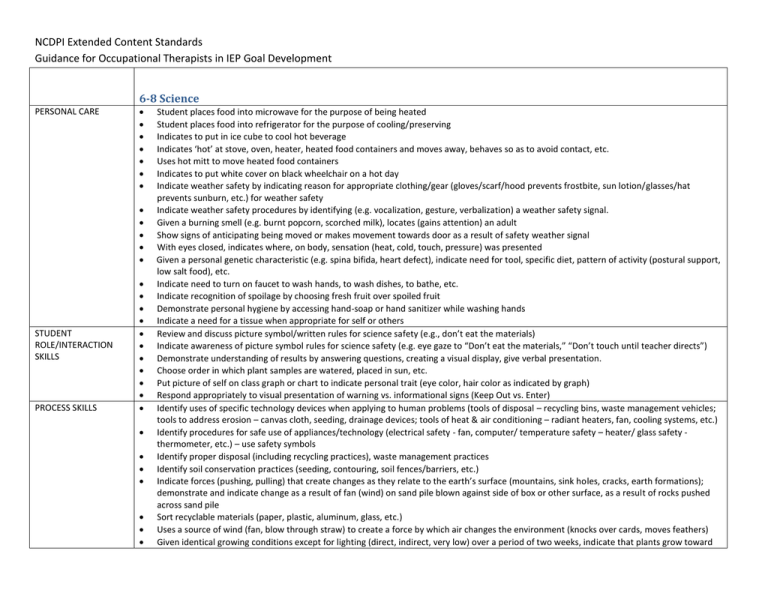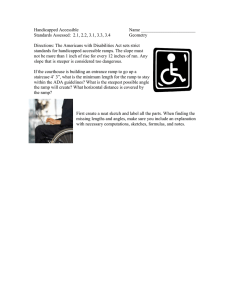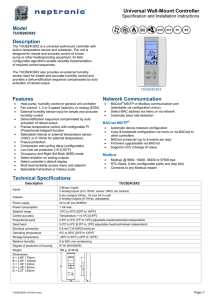NCDPI Extended Content Standards 6-8 Science
advertisement

NCDPI Extended Content Standards Guidance for Occupational Therapists in IEP Goal Development 6-8 Science PERSONAL CARE STUDENT ROLE/INTERACTION SKILLS PROCESS SKILLS Student places food into microwave for the purpose of being heated Student places food into refrigerator for the purpose of cooling/preserving Indicates to put in ice cube to cool hot beverage Indicates ‘hot’ at stove, oven, heater, heated food containers and moves away, behaves so as to avoid contact, etc. Uses hot mitt to move heated food containers Indicates to put white cover on black wheelchair on a hot day Indicate weather safety by indicating reason for appropriate clothing/gear (gloves/scarf/hood prevents frostbite, sun lotion/glasses/hat prevents sunburn, etc.) for weather safety Indicate weather safety procedures by identifying (e.g. vocalization, gesture, verbalization) a weather safety signal. Given a burning smell (e.g. burnt popcorn, scorched milk), locates (gains attention) an adult Show signs of anticipating being moved or makes movement towards door as a result of safety weather signal With eyes closed, indicates where, on body, sensation (heat, cold, touch, pressure) was presented Given a personal genetic characteristic (e.g. spina bifida, heart defect), indicate need for tool, specific diet, pattern of activity (postural support, low salt food), etc. Indicate need to turn on faucet to wash hands, to wash dishes, to bathe, etc. Indicate recognition of spoilage by choosing fresh fruit over spoiled fruit Demonstrate personal hygiene by accessing hand-soap or hand sanitizer while washing hands Indicate a need for a tissue when appropriate for self or others Review and discuss picture symbol/written rules for science safety (e.g., don’t eat the materials) Indicate awareness of picture symbol rules for science safety (e.g. eye gaze to “Don’t eat the materials,” “Don’t touch until teacher directs”) Demonstrate understanding of results by answering questions, creating a visual display, give verbal presentation. Choose order in which plant samples are watered, placed in sun, etc. Put picture of self on class graph or chart to indicate personal trait (eye color, hair color as indicated by graph) Respond appropriately to visual presentation of warning vs. informational signs (Keep Out vs. Enter) Identify uses of specific technology devices when applying to human problems (tools of disposal – recycling bins, waste management vehicles; tools to address erosion – canvas cloth, seeding, drainage devices; tools of heat & air conditioning – radiant heaters, fan, cooling systems, etc.) Identify procedures for safe use of appliances/technology (electrical safety - fan, computer/ temperature safety – heater/ glass safety thermometer, etc.) – use safety symbols Identify proper disposal (including recycling practices), waste management practices Identify soil conservation practices (seeding, contouring, soil fences/barriers, etc.) Indicate forces (pushing, pulling) that create changes as they relate to the earth’s surface (mountains, sink holes, cracks, earth formations); demonstrate and indicate change as a result of fan (wind) on sand pile blown against side of box or other surface, as a result of rocks pushed across sand pile Sort recyclable materials (paper, plastic, aluminum, glass, etc.) Uses a source of wind (fan, blow through straw) to create a force by which air changes the environment (knocks over cards, moves feathers) Given identical growing conditions except for lighting (direct, indirect, very low) over a period of two weeks, indicate that plants grow toward PLAY WRITTEN COMMUNICATION light Sorts living and non-living things Given a model of earth’s rotation around the sun, identify how day and night occur Given a model of earth’s rotation (tilted axis) around the sun, identify sequence of seasons Indicate light outside or at window when asked ‘where is the sun?’ Uses tuning fork (and other vibrating sound sources) to demonstrate transfer of vibration in at least one fashion (places tuning fork on own body to feel vibration, on hard surface to hear vibration of other surface, on surface of container filled with water to show waves in water) Indicates electrical outlet and behaves so as to avoid shock (where to hold plug, danger of prongs of plug, avoidance of standing water, dry off before operating electrical appliances) Given pictures of flocks, herds, crowds as well as ecosystems/habitats, indicates populations (similar, group, etc.) Identify safety procedures relating to severe weather When presented with various sounds, indicate the weather safety signal (tornado drill alarm versus dog barking) Given a family tree showing disease within a family, predict whether a disease is likely in children in this family Identify healthy life style choices (no cheeseburgers) that are important given predisposition to a disease (heart disease) Indicate physical traits that are inherited (eye color, skin color, dimples, hair color, etc.) vs. personal traits that are not (loud, hungry, short hair) Given a heavy object and a choice of two simple machines, indicates which machine will best move the object Indicate awareness of change in materials (wet vs. dry/clear vs. colored); Indicate uses of specific technology devices (thermometer, measuring tools for volume and mass, microscope, magnifying glass, first-aid kit, refrigerator, etc.) Categorize fresh water resources (lakes, streams, aquifers, ground water resources) vs. salt water resources (oceans, brackish water) Categorize water resources as safe/not safe for drinking Sequence illustrations to show how material is embedded in soil or rock, dissolves or crumbles, leaving an impression, and is replaced by sediment to create a cast Create impressions of animal shells and plants in plaster (or mud or other substance) and indicate connection (places in impression to match) between impression and shell or plant material Indicate that living things have cells and non-living do not, when given pictures or objects When presented with an example of an inclined plane (ramp) students will manipulate object up the ramp and indicate awareness regarding ramps Identify how exertion or exercise leads to increased heart rate When throwing an object from different distances at a flat surface, compares and predicts how far it will bounce back or roll During play (bowling, racing cars down ramp, etc.), indicate preference between ramps having different inclines to get faster roll During play (bowling, racing cars down ramp, etc.), indicate preference between ramps having different inclines to get faster roll Chart growth of plant (picture or other visual system) over days Create or fill in a model that illustrates the life cycle (food chain) within an ecosystem Create or fill in a model that illustrates the water cycle Graph number of students in class with a trait (hair color, eye color, dimples, roll tongue) to compare and contrast number of students with traits Create table (picture or other visual system) showing process (container of water-red powder-combined makes red liquid) Create a list of ways to conserve water in the home Create a pro/con chart on frequently used drugs: caffeine, alcohol, etc.


